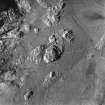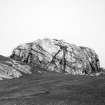Pricing Change
New pricing for orders of material from this site will come into place shortly. Charges for supply of digital images, digitisation on demand, prints and licensing will be altered.
Coll, Ballyhaugh, An Caisteal
Fort (Period Unassigned)
Site Name Coll, Ballyhaugh, An Caisteal
Classification Fort (Period Unassigned)
Canmore ID 21558
Site Number NM15NE 2
NGR NM 1718 5815
Datum OSGB36 - NGR
Permalink http://canmore.org.uk/site/21558
- Council Argyll And Bute
- Parish Coll
- Former Region Strathclyde
- Former District Argyll And Bute
- Former County Argyll
NM15NE 2 1718 5815.
An Caisteal - the slight remains of a fort.
Surveyed at 1:10,000.
Visited by OS (R L) 22 June 1972.
(NM 1718 5815) An Caisteal (NAT) Fort (NR) (remains of)
OS 1:10,000 map, (1976)
Fort, An Caisteal: Some traces of a fort, known locally as An Caisteal, are visible on an isolated rocky boss which rises to a height of about 12m above the surrounding land, 300m WNW of Ballyhaugh farmhouse. On three sides the cliffs fall away sheer for as much as 12m; the top of the boss is , however, accessible from the N over a natural terrace and thence by means of a narrow sloping shelf which ascends round the end of a low rock-face and along the edge of the cliff on the NW.
On the N and E the main wall (A on plan) occupied the crest of an upper terrace, but in the S half of the perimeter it followed the line of the cliff edge, linking rock outcrops. The area enclosed measured 29m from NW to SE by 26m transversely, but only a small proportion can have been habitable, for much of the interior is occupied by large areas of bare rock. A thin band of rubble is all that remains of the wall on the E, but on the W and SW four short stretches of outer facing-stones are still in situ. Where best preserved, on the SW, the wall-face consists of rounded boulders and survives to a height of 0.5m in two courses.
The last remnants of an outwork guarding the line of easiest approach are represented by some stony debris (B) lying along the margin of the lower terrace on the NE.
One or two doubtful hammer-stones were found here by Beveridge. (E Beveridge 1903)
E Beveridge 1903; RCAHMS 1980, visited 1975.
Note (6 November 2014 - 23 May 2016)
Traces of a small fortification can be seen on a rock boss close to the shore at Ballyhaugh. The boss falls away in cliffs up to 12m high everywhere except the N, from where the summit is accessible across a series of terraces that ascend the NW flank. At various points around the lip of the cliff traces of a wall can be seen, enclosing an area measuring about 29m from NW to SE by 26m transversely (0.06ha), while an outer wall has probably enclosed a lower terrace on the N. Nothing can be seen of the entrance itself, though the topography dictates that it was on the NW, and there are no visible features in the interior, which is largely bare rock.
Information from An Atlas of Hillforts of Great Britain and Ireland – 23 May 2016. Atlas of Hillforts SC2492






























